Related Research Articles
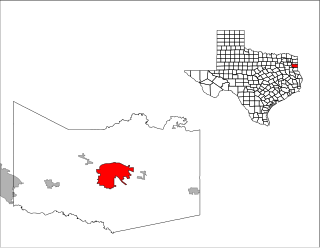
Marshall is a city in the U.S. state of Texas. It is the county seat of Harrison County and a cultural and educational center of the Ark-La-Tex region. At the 2020 U.S. census, the population of Marshall was 23,392. The population of the Greater Marshall area, comprising all of Harrison County, was 65,631 in 2010 and 66,726 in 2018.
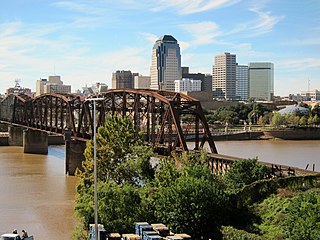
Shreveport is a city in the U.S. state of Louisiana. It is the third-most populous city in Louisiana after New Orleans and Baton Rouge. The bulk of Shreveport is in Caddo Parish, of which it is the parish seat. It extends along the west bank of the Red River into neighboring Bossier Parish. The 2020 census tabulation for the city's population was 201,573, while the Shreveport–Bossier City metropolitan area had a population of 393,406.

Georgetown is a historic neighborhood and commercial district in Northwest Washington, D.C., situated along the Potomac River. Founded in 1751 as part of the colonial-era Province of Maryland, Georgetown predated the establishment of Washington, D.C. by 40 years. Georgetown was an independent municipality until 1871 when the United States Congress created a new consolidated government for the entire District of Columbia. A separate act, passed in 1895, repealed Georgetown's remaining local ordinances and renamed Georgetown's streets to conform with those in Washington, D.C.
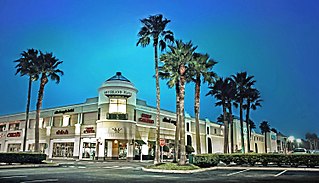
Meyerland is a community in southwest Houston, Texas, outside of the 610 Loop and inside Beltway 8. The neighborhood is named after the Meyer family, who bought and owned 6,000 acres (24 km2) of land in southwest Houston.

Fourth Ward is one of the historic six wards of Houston, Texas, United States. The Fourth Ward is located inside the 610 Loop directly west of and adjacent to Downtown Houston. The Fourth Ward is the site of Freedmen's Town, which was a post-U.S. Civil War community of African-Americans.
Hamilton Park is a neighborhood in north Dallas, Texas (USA), named for Dr. Richard T. Hamilton, a physician and black civic leader. It is located in Northwest Lake Highlands, on the southeastern side of the North Central Expressway /I-635 interchange, north of Forest Lane, and west of DART's Red Line light-rail line. The neighborhood had a population of 2,148 in 1990.

The Clarksville Historic District in Austin, Texas, is an area located west of downtown Austin near Lady Bird Lake and just northeast of the intersection of the Missouri Pacific Railroad and West Tenth Street. Many historic homes and structures are located within the Clarksville Historic District. While Clarksville is geographically part of the Old West Austin Historic District, it is distinct from the two historic neighborhoods of Old Enfield, which lies immediately to the north on the eastern side of Texas State Highway Loop 1, and Tarrytown, which is situated to the west and northwest on the western side of Mopac.
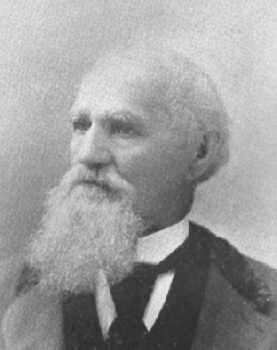
John Henry Brown was an American journalist, military leader, author, politician, and historian, who served as a state legislator and as mayor of both Galveston (1856) and Dallas, Texas (1885–1887). Brown was among the first to publish scholarly histories of the state of Texas and the city of Dallas.
Elm Thicket is a primarily residential neighborhood in North Dallas, Texas near Love Field airport and the neighborhoods of Love Field, Bluffview, Greenway Parks, University Park and Highland Park.
Bonton is a historically African-American neighborhood in South Dallas, Texas. The area, zip code 75215, is bounded by Hatcher St. and S Central Expressway to the North and West, respectively, and goes as far as Municipal St. and Donald St. to its East and South. Lauren Woods and Cynthia Mulcahy, artists/researchers, put forth in their Dallas Historical Parks Project, that the name "Bon Ton" is possibly to be derived from the French expression "bon ton," translating to high society, fashionable manner, or style. This was a popular adjective in black society in the early 20th century. Advertisements in local black newspapers like The Dallas Express, used the phrase "High Classed, Bon Ton, Restricted Residences for Negroes" to describe the new housing developments in this area of South Dallas. Bonton was also once closely linked to the black arts and culture district called Deep Ellum, as a direct road originally connected the two areas. The two main racial groups represented in the neighborhood are African Americans and Hispanics, with the former constituting over 75% of the population. Many of Bonton's residents are disadvantaged, with 42.9% of the populace falling below the poverty line and 65% failing to complete high school or achieve an equivalent degree. As factors like these contributed to rising incidents of crime and other social ills, the battle to revitalize the area was born, one that still rages today.

Richard Henry Boyd was an African-American minister and businessman who was the founder and head of the National Baptist Publishing Board and a founder of the National Baptist Convention of America, Inc.

Guadalupe College was a private Baptist college for African Americans in Seguin, Texas. It was established in 1884 and opened officially in 1887. Its founding was chiefly due to the efforts of William B. Ball, who later became its president. David Abner Jr. was president of Guadalupe College from 1891 to 1906, a 15-year tenure during which the college flourished and gained statewide recognition. At its height during his administration, the college had an enrollment of approximately 500 students.
Macedonia Park, also known as Bagley Park, was a development in what is now the Buckhead Community of Atlanta, Georgia, United States. It was located on the present site of Frankie Allen Park in the Garden Hills neighborhood. It was situated in District 17, Land Lot 60. While many African-Americans lived in the area from 1870 to 1920, streets and addresses were not assigned until the area was developed by John Sheffield Owens, a white developer, in 1921. Despite the area's development, the homes were systemically bought up by Fulton County in the 1940s-50s. The county cited water quality issues and ordered a clean-up of the area, which ultimately led to the razing of the neighborhood.

William Sidney Pittman was an American architect who designed several notable buildings, such as the Zion Baptist Church and the nearby Deanwood Chess House in the Deanwood neighborhood of Washington, D.C. He was the son-in-law of Booker T. Washington.
Spanish Camp is an unincorporated community in north central Wharton County, in the U.S. state of Texas. The community is located between Egypt and Hungerford along Farm to Market Road 1161, (FM 1161) near its intersection with Farm to Market Road 640 (FM 640). After the Mexican army of Antonio López de Santa Anna camped at the site in 1836, the community took the name Spanish Camp. In 1870, a church in the community was founded by former slaves and the congregation still existed as of 2013.
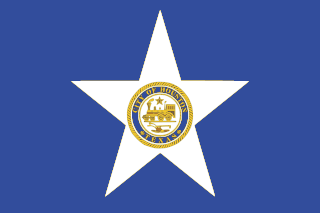
The African American population in Houston, Texas, has been a significant part of the city's community since its establishment. The Greater Houston area has the largest population of African Americans in Texas and west of the Mississippi River. Black Enterprise has referred to Houston as a Black mecca.

Texana A. Castle was an African-American Baptist, who lived in Bryan, Texas for most of her life. She was affiliated with Baptist missionary projects and founded the Bryans Colored Rescue Home in the mostly African-American community of Boonville, Texas.
Lyttonsville is a mostly residential neighborhood of Silver Spring, Maryland. Established in the 1850s, it is among the oldest neighborhoods in Montgomery County and is a notable example of a community created by free African Americans before the Civil War. Today, Lyttonsville is a 68-acre, predominantly residential neighborhood mostly composed of small single-family homes.

The Tenth Street Freedman's Town is a historic African American community in the Oak Cliff section of Dallas, Texas. A freedmen's town is a community settled by formerly enslaved people who were emancipated during and after the American Civil War. The freedmen's town that became known as Tenth Street began near the confluence of Cedar Creek and Cedar Creek Branch, at the foot of an African American burial ground dating back to 1846. The name "Tenth Street" became associated with the community in 1887, when John Scarborough Armstrong and Thomas Lafayette Marsalis platted the town of Oak Cliff.
References
- 1 2 3 4 5 Maxwell, Lisa C. (June 15, 2010). "Little Egypt, Texas". Texas Handbook Online. Texas State Historical Association. Retrieved April 15, 2017.
- ↑ Cannon, Bill (1997). A Treasury of Texas Trivia. Lanham, Maryland: Republic of Texas Press. p. 178. ISBN 9781461732778.
- ↑ Gutierrez, Kris. "Students Research Forgotten All-Black Community". NBC 5 Dallas-Fort Worth. Retrieved April 15, 2017.
- ↑ Ragland, James (November 4, 2016). "Empty lot in northeast Dallas may offer clues about old black settlement known as Little Egypt". Dallas News. Retrieved April 15, 2017.
- 1 2 3 Young, Michael E. (February 24, 2002). "Life was hard in freedman's town called Little Egypt". Houston Chronicle. Retrieved April 15, 2017.
- ↑ Wilonsky, Robert (July 7, 2015). "Two Dallas cemeteries dating back to the 1800s begin long road to historic designation". Dallas News. Retrieved April 15, 2017.
- 1 2 3 "Little Egypt Families Leave Shacks for Modern Homes". Albuquerque Journal. May 16, 1962. Retrieved April 15, 2017– via Newspapers.com.
- 1 2 3 4 Holdbrook, Raymond (May 15, 1962). "Century-Old Dallas Negro Colony Abandoned, Residents to Scatter". Corsicana Daily Sun. Retrieved April 15, 2017– via Newspapers.com.
- ↑ "Little Egypt: A New Life for Negroes". The Oneonta Star. May 16, 2017. Retrieved April 15, 2017– via Newspapers.com.
- ↑ Babb, Christina Hughes (August 2, 2011). "Lake Highlands history lesson: Little Egypt". Lake Highlands. Retrieved April 15, 2017.
- ↑ "Little Egypt Residents in Hopeful Move". Denton Record-Chronicle. May 16, 1962. Retrieved April 15, 2017– via Newspapers.com.